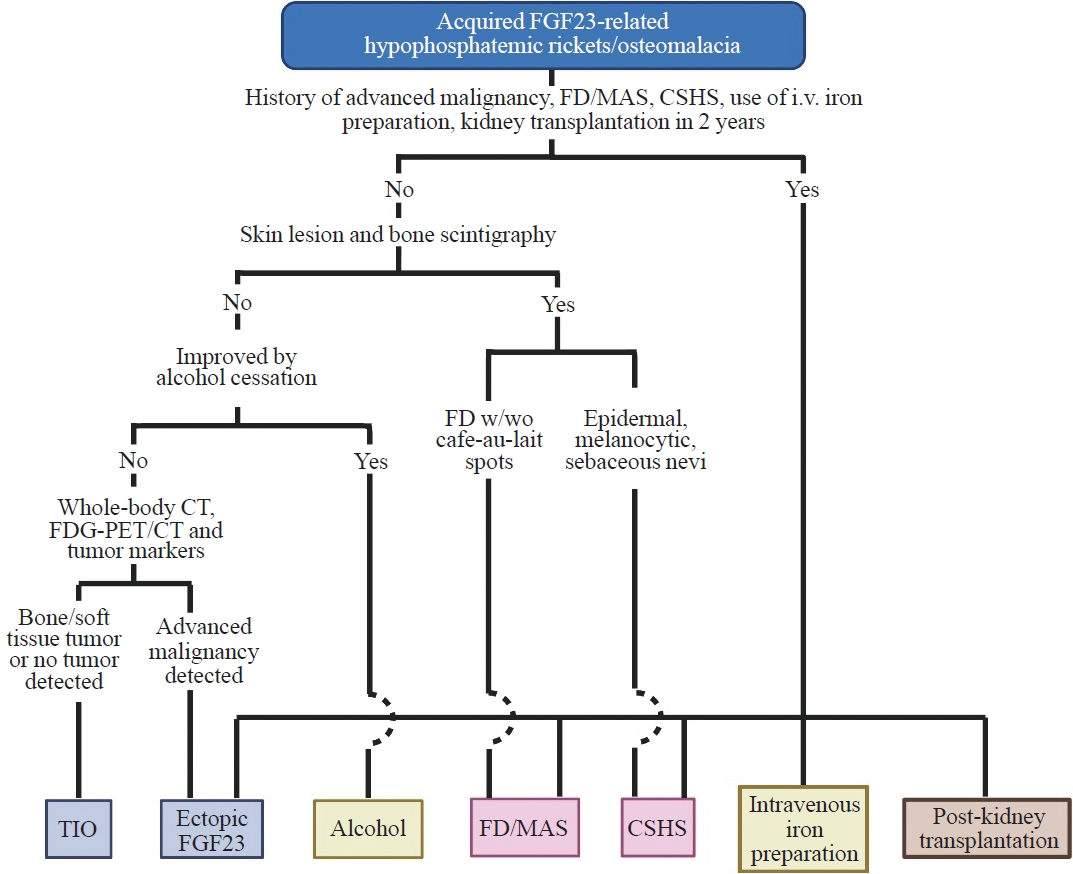Search
- Page Path
- HOME > Search
Review Article
- Calcium & bone metabolism
- Acquired Forms of Fibroblast Growth Factor 23-Related Hypophosphatemic Osteomalacia
- Nobuaki Ito, Naoko Hidaka, Hajime Kato
- Endocrinol Metab. 2024;39(2):255-261. Published online March 11, 2024
- DOI: https://doi.org/10.3803/EnM.2023.1908

- 1,496 View
- 79 Download
-
 Abstract
Abstract
 PDF
PDF PubReader
PubReader  ePub
ePub - Fibroblast growth factor 23 (FGF23) is a pivotal humoral factor for the regulation of serum phosphate levels and was first identified in patients with autosomal dominant hypophosphatemic rickets and tumor-induced osteomalacia (TIO), the most common form of acquired FGF23-related hypophosphatemic rickets/osteomalacia (FGF23rHR). After the identification of FGF23, many other inherited and acquired forms of FGF23rHR were reported. In this review article, the detailed features of each acquired FGF23rHR are discussed, including TIO, ectopic FGF23 syndrome with malignancy, fibrous dysplasia/McCune-Albright syndrome, Schimmelpenning-Feuerstein-Mims syndrome/cutaneous skeletal hypophosphatemia syndrome, intravenous iron preparation-induced FGF23rHR, alcohol consumption-induced FGF23rHR, and post-kidney transplantation hypophosphatemia. Then, an approach for the differential diagnosis and therapeutic options for each disorder are concisely introduced. Currently, the majority of endocrinologists might only consider TIO when encountering patients with acquired FGF23rHR; an adequate differential diagnosis can reduce medical costs and invasive procedures such as positron emission tomography/computed tomography and venous sampling to identify FGF23-producing tumors. Furthermore, some acquired FGF23rHRs, such as intravenous iron preparation/alcohol consumption-induced FGF23rHR, require only cessation of drugs or alcohol to achieve full recovery from osteomalacia.

Case Report
- A Case of Tumor-induced Osteomalacia with Elevated Fibroblast Growth Factor-23.
- Hae Sung Kim, Hyun Seung Jung, Hee Jung Kim, Sung Yeon Kim, Sang Wan Kim, Chan Soo Shin, Chong Jai Kim, Seong Yeon Kim
- J Korean Endocr Soc. 2007;22(2):142-148. Published online April 1, 2007
- DOI: https://doi.org/10.3803/jkes.2007.22.2.142
- 2,010 View
- 22 Download
- 12 Crossref
-
 Abstract
Abstract
 PDF
PDF - Tumor-induced osteomalacia (TIO), a paraneoplastic disease, is characterized by hypophosphatemia, and caused by renal phosphate wasting inappropriately, normal or decreased 1, 25(OH)2D3 production, and defective calcification of cartilage and bone. Because the removal of the responsible tumor normalizes phosphate metabolism, unidentified humoral phosphaturic factors (phosphatonin) are believed to be responsible for this syndrome. These factors include fibroblast growth factor (FGF)-23, secreted frizzled-related protein-4 and matrix extracellular phosphoglycoprotein. However, no case of TIO producing FGF-23 has been clearly reported in Korea. Herein, a case of TIO producing FGF-23 in a 45-year-old woman is reported. The patient presented with a large tumor on her buttock, with severe bone and muscle pain. A histological examination of the tumor revealed a mixed connective tissue tumor, consisting of deposition of calcified materials and surrounding primitive spindle cells, with prominent vascularity. Whether FGF-23 is a secreted factor, as well as its levels of expression in tumors were investigated. An immunohistochemical study showed the tumor cells to be FGF-23 positive. Furthermore, the levels of serum FGF-23 were extremely high and an RT-PCR analysis, using total RNA from the tumor, revealed the abundant expression of FGF-23 mRNA. After removal of the tumor, all the biochemical and hormonal abnormalities disappeared, with marked symptomatic improvement.
-
Citations
Citations to this article as recorded by- Change in Patient's Ages Who Took an Adenoidectomy for 30 Years
Eun Jung Lee, Ji Hoon Kim, Hye Jin Hwang, Min Ki Kim, Min Seok Kang, Kyung-Su Kim
Journal of Rhinology.2017; 24(1): 8. CrossRef - Dietary assessment according to frequency of food consumed away from home among children and adolescents: Based on the 2010~2012 Korea National Health and Nutrition Examination Survey
Yong-Suk Kwon, Wan-Soo Hong, Seyoung Ju
Journal of Nutrition and Health.2016; 49(6): 471. CrossRef - Dyslipidemia in Children and Adolescents: When and How to Diagnose and Treat?
Jung Min Yoon
Pediatric Gastroenterology, Hepatology & Nutrition.2014; 17(2): 85. CrossRef - Length and Volume of Morphologically Normal Kidneys in Korean Children: Ultrasound Measurement and Estimation Using Body Size
Jun-Hwee Kim, Myung-Joon Kim, Sok Hwan Lim, Jieun Kim, Mi-Jung Lee
Korean Journal of Radiology.2013; 14(4): 677. CrossRef - Factors Influencing Obesity among Adolescent: Analysis of 2011 Korean Youth Risk Behavior Survey
Young-Ju Jee, Young-Hae Kim
The Korean Journal of Obesity.2013; 22(1): 39. CrossRef - A Case of Nutritional Osteomalacia in Young Adult Male
Choong-Kyun Noh, Min-Jeong Lee, Bu Kyung Kim, Yoon-Sok Chung
Journal of Bone Metabolism.2013; 20(1): 51. CrossRef - The Relationship between High Energy/Low Nutrient Food Consumption and Obesity among Korean Children and Adolescents
Gyu Jin Heo, So-Young Nam, Soo-Kyung Lee, Sang-Jin Chung, Ji hyun Yoon
Korean Journal of Community Nutrition.2012; 17(2): 226. CrossRef - Changes in Prevalence of Obesity and Underweight among Korean Children and Adolescents: 1998-2008
Ki Eun Kim, Shin Hye Kim, Sangshin Park, Young-Ho Khang, Mi Jung Park
The Korean Journal of Obesity.2012; 21(4): 228. CrossRef - A new age-based formula for estimating weight of Korean children
Jungho Park, Young Ho Kwak, Do Kyun Kim, Jae Yun Jung, Jin Hee Lee, Hye Young Jang, Hahn Bom Kim, Ki Jeong Hong
Resuscitation.2012; 83(9): 1129. CrossRef - Lipid Profiles and Prevalence of Dyslipidemia in Korean Adolescents
Shin Hye Kim, Byung Chul Ahn, Hyojee Joung, Mi Jung Park
Endocrinology and Metabolism.2012; 27(3): 208. CrossRef - Trends in obesity among Korean children using four different criteria
Young-Ho Khang, Mi Jung Park
International Journal of Pediatric Obesity.2011; 6(3-4): 206. CrossRef - Usefulness of the Waist Circumference-to-Height Ratio in Screening for Obesity in Korean Children and Adolescents
Joo Hyun Gil, Mi Na Lee, Hye Ah Lee, Hyesook Park, Jeong Wan Seo
Korean Journal of Pediatric Gastroenterology and Nutrition.2010; 13(2): 180. CrossRef
- Change in Patient's Ages Who Took an Adenoidectomy for 30 Years


 KES
KES

 First
First Prev
Prev



